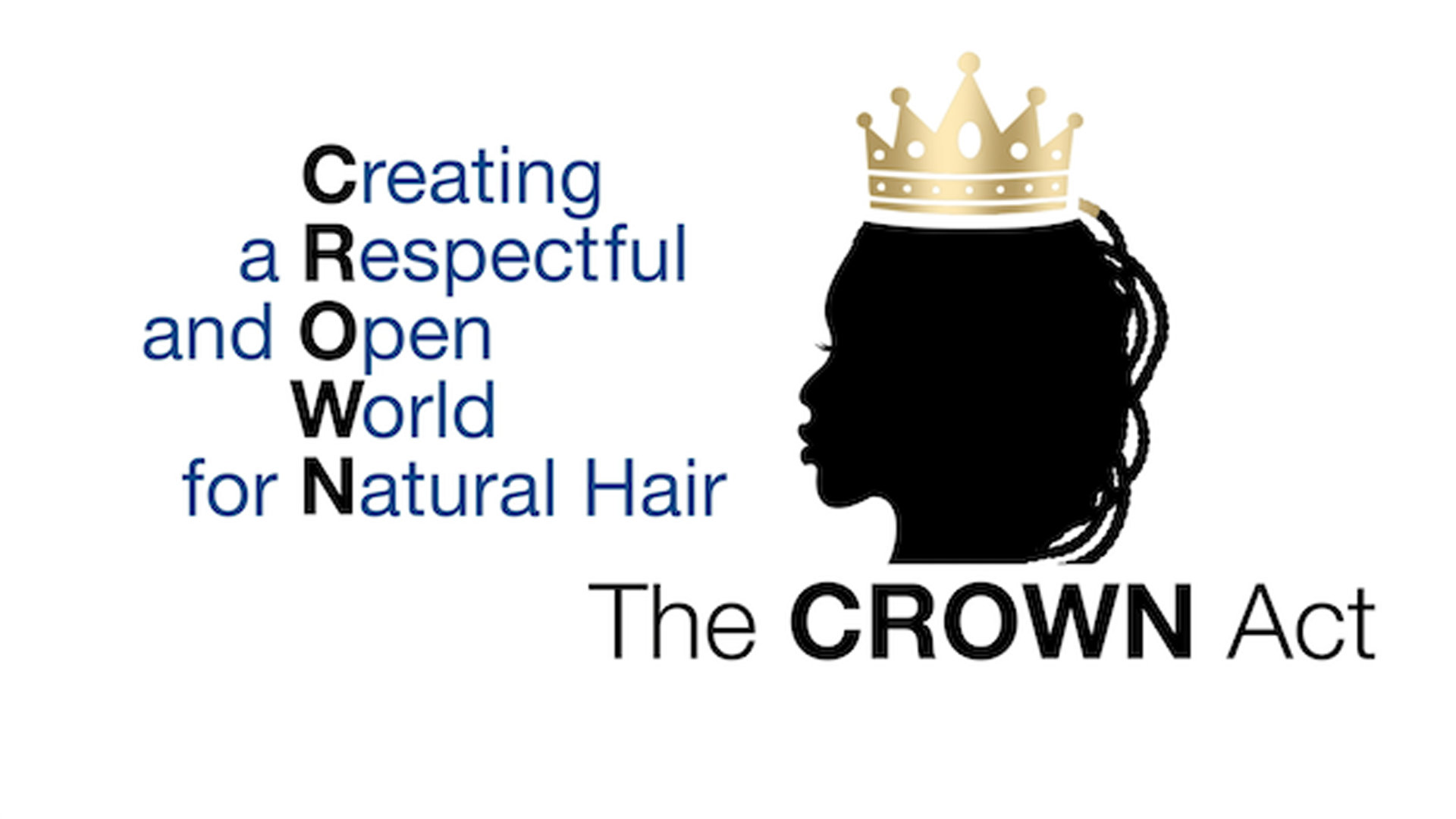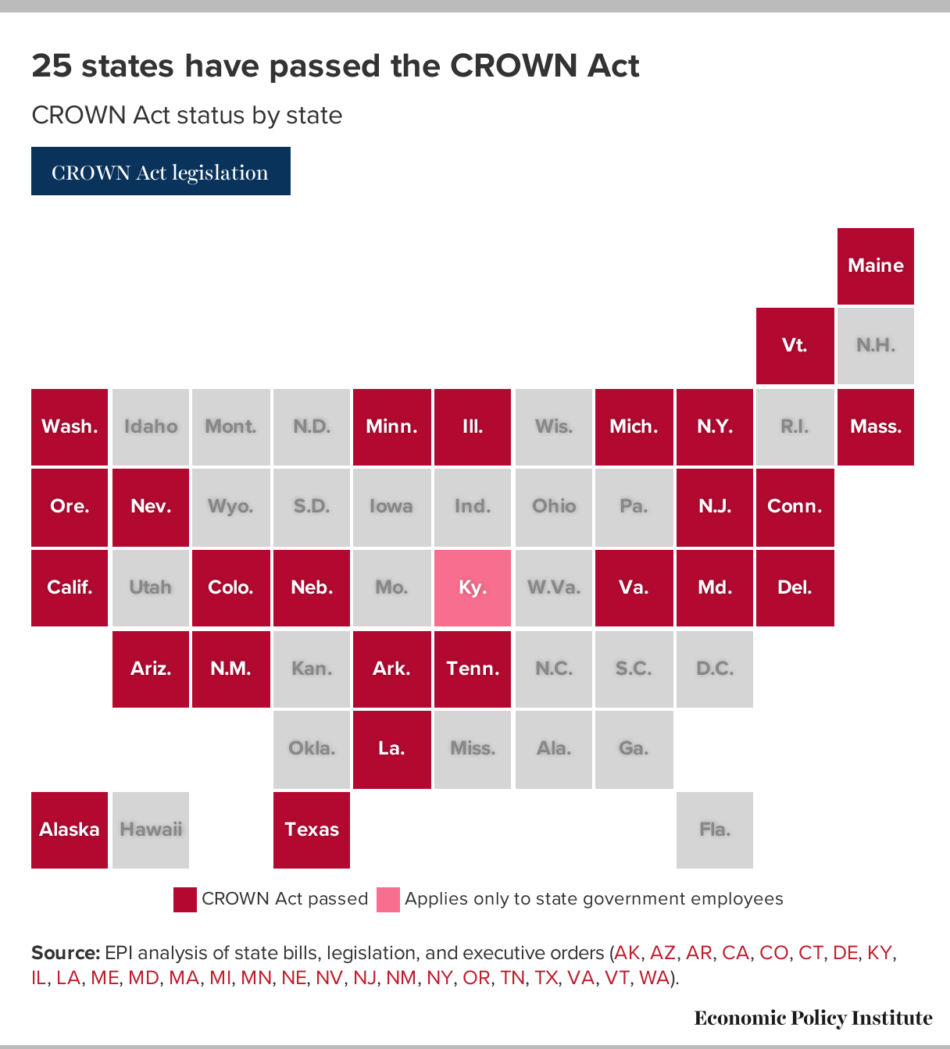Model CROWN Act Ties Natural Hair Texture & Protective Hairstyles to Race/Ethnicity Discrimination Protections
EEOC Enforcement Stances Similar to Model CROWN Act
No Current Legal Consensus on Whether Title VII’s Race Discrimination Prohibition Covers Natural Hair Texture/Related Protective Styles

New Hampshire became the 26th U.S. State to enact its version earlier this month. Specifically, Governor Christopher Sununu (R) signed into law HB 1169: Creating a private cause of action for discrimination based on hairstyles relative to a person’s ethnicity.
Readers may recall our early April story and DE Under 3 video about how an Equal Employment Opportunity Commission (“EEOC”) Consent Decree illustrated that agency’s enforcement stance regarding natural hair texture and race discrimination. In that story, we discussed the current state of federal law on this issue. We also noted that (then) roughly 23 states (and multiple localities) have enacted this legislation [the CROWN Act], in various forms, some of which do not conform completely with the model version of the measure.
EEOC Enforcement Stance
In our April 4, 2024 story, we reported on an EEOC statement announcing a recent Consent Decree. Importantly, the EEOC explicitly stated that natural hair texture counts as an “immutable characteristic of race” covered by Title VII. Accordingly, the Commission concluded that prohibiting a Black employee from wearing her hair in its natural state constitutes race discrimination in violation of Title VII. In the case before the Commission, the employee was female, but this enforcement stance would apply regardless of gender.
We also explained that, currently, there is no legal consensus as to whether Title VII’s prohibition on race discrimination covers natural hair texture. Meanwhile, there is a movement to amend federal law to have the definition of race discrimination in Title VII not only explicitly include natural hair texture but also to protect certain hairstyles.
Protective Hairstyles
The hairstyles covered under the model CROWN Act are those designed to protect the health of naturally curly hair. Those styles may include braids, locs, twists or bantu knots. The Texas CROWN Act website offers this definition of protective hairstyles:
“A protective hairstyle is a style that tucks the ends of the hair away from being exposed to damaging agents such as sun, heat, and constant manipulation.”
Updated State Tally
A July 1, 2024, article from the Economic Policy Institute (“EPI”) (prior to New Hampshire’s July 3rd enactment of the measure) contains the following graphic:
The EPI article also notes:
“While becoming law in 25 states is critically important, the bill still has a long way to go to protect everyone. More than 10 states have considered CROWN Act bills in the past few years but failed to pass them, including Florida, New Hampshire, and Ohio.”
The model CROWN Act website has similar information and notes that both the Kentucky and Arizona measures are via Executive Orders rather than legislation. That website also reports that versions of the CROWN Act have been enacted in about 40 localities.
On May 3, 2024 (prior to New Hampshire’s recent enactment), NPR reported that:
“California was the first state to sign the act into law back in 2019 [July 3] and has since been joined by 24 states and the U.S. Virgin Islands. Texas [in September 2023] is the latest state to implement a version of the law. The legislation has been proposed in 20 additional states and Washington, D.C.” [embedded links omitted]
Variations in State-Level Laws
The difference in most state laws is the varying degrees of coverage regarding education and employment. Also important is that some state CROWN Act laws contain loopholes/exemptions that enable the discriminatory targeting of protective hairstyles. This article from the Brookings Institute explains an example of this type of exemption in Texas. Currently, there is a movement to amend the Texas law to cover protective hairstyles.
New Developments on Federal Level
On the federal level, since our story in early April, CROWN Act bills were introduced in both the Senate (bipartisan) and the House:
- In the Senate, on May 1, 2024: S.4224 – CROWN Act of 2024 was introduced by Cory Booker (D-NJ) and cosponsored by Susan Collins (R-ME).
- In the House, on April 30, 2024: H.R.8191 – Creating a Respectful and Open World for Natural Hair Act of 2024 was introduced by Representative Bonnie Watson Coleman (D-NJ) with 88 cosponsors, all Democrats.
Both of the above bills would, if enacted into law, amend Title VII to provide that:
“It shall be an unlawful employment practice for an employer, employment agency, labor organization, or joint labor-management committee controlling apprenticeship or other training or retraining (including on-the-job training programs) to fail or refuse to hire or to discharge any individual, or otherwise to discriminate against an individual, based on the individual’s hair texture or hairstyle, if that hair texture or that hairstyle is commonly associated with a particular race or national origin (including a hairstyle in which hair is tightly coiled or tightly curled, locs, cornrows, twists, braids, Bantu knots, and Afros).” (emphasis added)
Even though this legislation is unlikely to pass at the federal level anytime soon, since over half the states now have some version of it, employers should be aware of this state law trend.
How Hair Texture & Hairstyle Ties into Race & National Origin Discrimination
The model CROWN Act and the text of the bills currently pending in the House and Senate tie hair texture and curly hair to race and national origin discrimination. Both the House and Senate bills state that:
- “Throughout United States history, society has used (in conjunction with skin color) hair texture and hairstyle to classify individuals on the basis of race.
- Like one’s skin color, one’s hair has served as a basis of race and national origin discrimination.
- Racial and national origin discrimination can and do occur because of longstanding racial and national origin biases and stereotypes associated with hair texture and style.”
While the text of these federal bills cites several examples of historical discrimination against people of African descent in particular, the prohibition against hair texture and hairstyle discrimination is not limited to any one race or ethnicity/national origin. Under this legislation, discrimination would be prohibited when the hair texture or hairstyle is commonly associated with a particular race or national origin, regardless of what that race or national origin may be.
Dangers of Altering Hair Texture
While hair texture is innate, it is technically alterable. However, the chemicals required to effectively straighten hair, especially the tightest curls and coils, involve significant health risks, including increased cancer risk. For examples and more information, see here and here. Accordingly, requiring people to alter their natural hair to meet beauty and professional standards associated with a more favored racial or ethnic/national origin group (i.e., Eurocentric) involves unwarranted health risks – not to mention the time and monetary cost involved.
Advocates Explain Necessity of CROWN Act
A legion of articles/blogs provide background on why advocates believe the CROWN Act is necessary to ensure protection against race/ethnicity/national origin discrimination. Among those, we highlight the following two examples.
- “With no nationwide legal protections against hair discrimination, Black people are often left to risk facing consequences at school or work for their natural hair or invest time and money to conform to Eurocentric professionalism and beauty standards,” notes the NAACP Legal Defense Fund.
- The model CROWN Act website reports on a 2023 CROWN Workplace Research Study (that Dove (the soap brand) and LinkedIn co-commissioned) which found that:
- Black women’s hair is 2.5x more likely to be perceived as unprofessional;
- Approximately 2/3 of Black women (66%) change their hair for a job interview. Among them, 41% changed their hair from curly to straight;
- Black women are 54% more likely (or over 1.5x more likely) to feel like they have to wear their hair straight to a job interview to be successful;
- Black women with coily/textured hair [see the Andre Walker Hair Typing System] are 2x as likely to experience microaggressions in the workplace than Black women with straighter hair;
- Over 20% of Black women 25-34 have been sent home from work because of their hair;
- Nearly half (44%) of Black women under age 34 feel pressured to have a headshot with straight hair; and
- 25% of Black women believe they have been denied a job interview because of their hair, which is even higher for women under 34 (1/3).
THIS COLUMN IS MEANT TO ASSIST IN A GENERAL UNDERSTANDING OF THE CURRENT LAW AND PRACTICE RELATING TO OFCCP. IT IS NOT TO BE REGARDED AS LEGAL ADVICE. COMPANIES OR INDIVIDUALS WITH PARTICULAR QUESTIONS SHOULD SEEK ADVICE OF COUNSEL.
SUBSCRIBE.
Subscribe to receive alerts, news and updates on all things related to OFCCP compliance as it applies to federal contractors.
OFCCP Compliance Text Alerts
Get OFCCP compliance alerts on your cell phone. Text the word compliance to 18668693326 and confirm your subscription. Provider message and data rates may apply.

